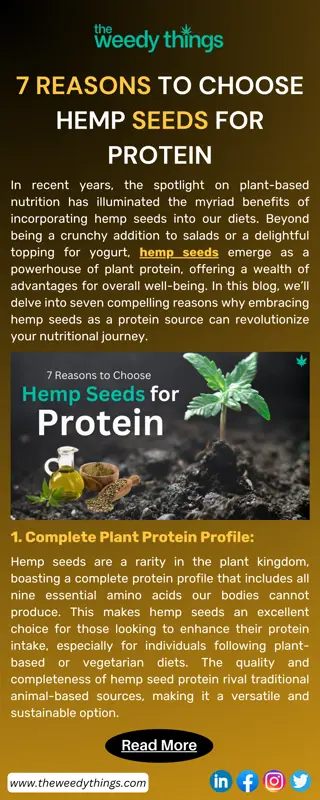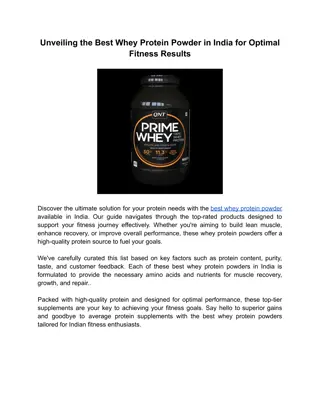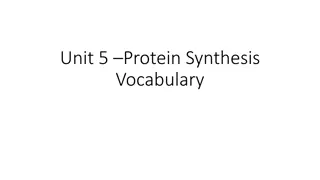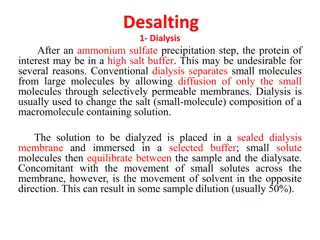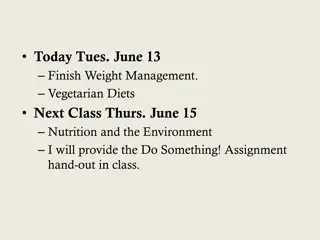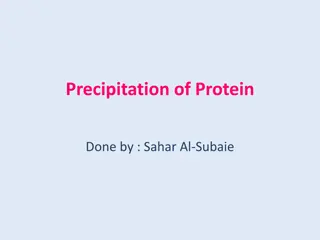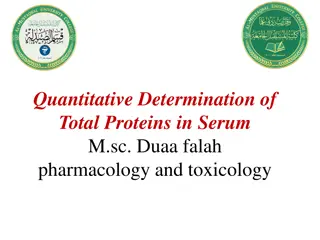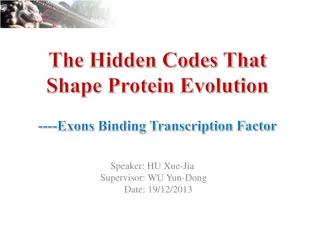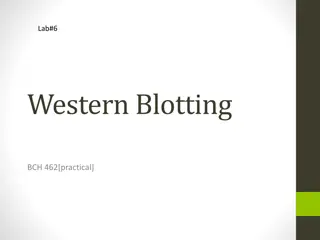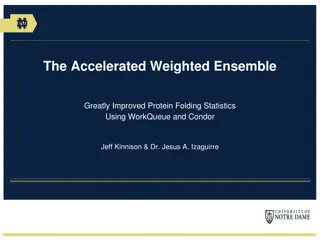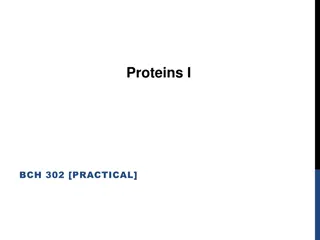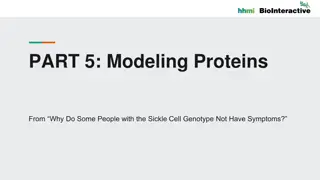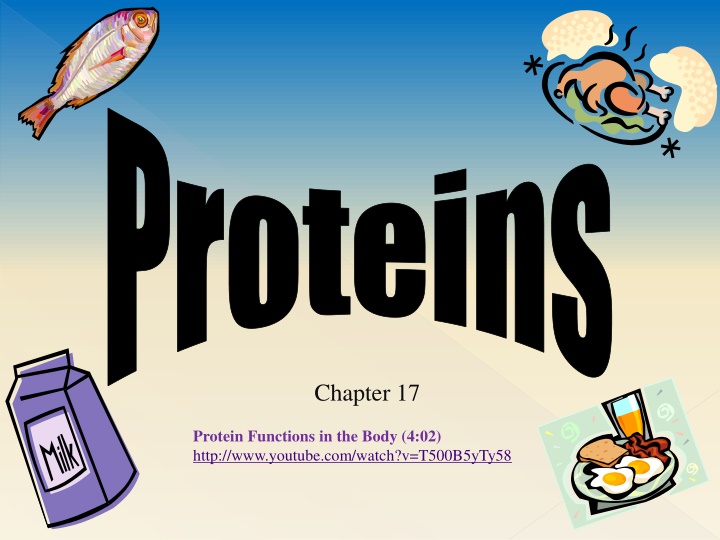
Proteins: Functions, Structure, and Denaturation
Explore the world of proteins, from their essential functions in the body to their intricate structures. Learn about the diverse roles proteins play, the importance of amino acids, and how denaturation alters protein shape. Discover the impact of heat, pH levels, and other factors on protein denaturation.
Download Presentation

Please find below an Image/Link to download the presentation.
The content on the website is provided AS IS for your information and personal use only. It may not be sold, licensed, or shared on other websites without obtaining consent from the author. If you encounter any issues during the download, it is possible that the publisher has removed the file from their server.
You are allowed to download the files provided on this website for personal or commercial use, subject to the condition that they are used lawfully. All files are the property of their respective owners.
The content on the website is provided AS IS for your information and personal use only. It may not be sold, licensed, or shared on other websites without obtaining consent from the author.
E N D
Presentation Transcript
Proteins Chapter 17 Protein Functions in the Body (4:02) http://www.youtube.com/watch?v=T500B5yTy58
What is a protein? Large and complex molecules Made of hydrogen, carbon, oxygen, nitrogen Often called macromolecules because of their large size containing many atoms. Nitrogen is a crucial part of protein, gives proteins their variety and versatility
What is a protein? Continued Human body contains 10,000 to 50,000 different proteins Made from chemical compounds called amino acids There are 22 amino acids Our bodies make all but 9 of them
Structure of Protein Made from chains of amino acids Amino acids consists of two groups Carboxyl group, carbon bonded to oxygen by a double covalent bond, and to a hydroxyl group with a single bond (-COOH) Amine group, two atoms of hydrogen and one atom of nitrogen (-NH2) Glycine simplest amino acid
Structure of Protein Continued Peptide Bonds, bonds between nitrogen of one amino acid and the carbon of a second amino acid Polypeptide, a single protein molecule containing ten or more amino acids linked in peptide chains
Structure and Function Shape determines the proteins function. Fibrous protein form rope-like fibers, this structure strengthens them to serve as connective tissue in the body such as collagen, hair, skin and nails. Globular proteins form a rounded shape, this structure makes them convenient carriers such as hemoglobin.
Structure and Function Continued Protein Denaturation (3:44) http://www.youtube.com/watch?v=v2-iY7ZoDOc Denaturation is a process of changing the shape of a protein molecule without breaking its peptide bonds. Coagulation changes a liquid into a soft, semisolid clot or solid mass.
Means of Denaturation Heat most common Freezing, pressure, sound waves and addition of certain compounds Mechanical treatment (beating eggs, kneading dough) How to Knead Dough (2:45) http://www.youtube.com/watch?v=ySOj0fFWo1U Very high or very low pH (adding lemon juice) Metal ions, (Sodium, potassium, copper and iron)
Protein in Foods Eggs contain almost every vitamin and mineral you need Meat contains fibrous proteins called actin and myosin. These proteins form bundles of fibers, which are held together by connective tissue made of collagen and elastin, two proteins with long, strong molecules. Cooking meat is more complex due to variations in fat and types of muscle fibers and connective tissue. Fish contain shorter, segmented muscle fibers that are layered between thin sheets of connective tissue. Takes less time to cook. Nuts and Legumes carry lots of nutrients, cholesterol free but fat content ranges from zero to very high. Soybean proteins are equal to that in foods from animals.
Protein in Cooking oEmulsifiers keep foods blended together. Ex: salad dressing, mayonnaise oFoams air bubbles incorporated and trapped in a protein film by whipping. Foam adds volume and lightness to a recipe oGelatin animal protein used to set desserts and thicken meat sauces oGluten an elastic substance formed by mixing water with the proteins found in wheat, gives baked goods their structure and shape.
Function of Body Proteins Structural protein is needed for every cell in the body. Collagen helps build bones, the ligaments that bind them, the tendons that connect them to muscles, and the muscles themselves. New Growth replace and repair cells Enzymes and hormones that are responsible for body processes. (hormones aid in growth, balance fluid, regulate metabolism) Transports nutrients in cells. (lipoproteins, oxygen) Antibody proteins help ward off disease Stabilize pH levels Supply energy if needed 1 2 3 4 5 6 7
9 Essential Amino Acids Essential Amino Acids you need to eat every day. They come from animals source. Soybeans are the only plant source that provides them Unfortunately these contain saturated fat and cholesterol
Two Types of Proteins Complete Protein supplies all 9 essential amino acids Meat Fish Poultry Dairy (milk, cheese, yogurt) Eggs Soy Incomplete Protein lacking one or more essential amino acids Plant sources, must be eaten in greater variety Rice with beans Legumes Nuts Seeds Grains vegetables Different Types of Proteins ( 3:07) http://www.youtube.com/watch?v=DRHCVQEIAwc
How much protein do you need? Depends on Age Gender Body size Activity level Children, pregnant women, and nursing mothers need higher levels
Food Grams of protein per serving Tuna (3 ounces) 22 Age 15-18 Hamburger (3 ounces) 21 Chicken (3 ounces) 21 Shrimp (3 ounces) 18 Multiply your weight by 0.36 to estimate how many grams of protein do you need each day? Tempeh ( cup) 15 Yogurt (1 cup) 11 Tofu ( cup) 9 Lentils, cooked ( cup) 9 Cow's milk (1 cup) 8 Peanut butter (2 tbsp) 8 Kidney beans, cooked ( cup) 8 Example if you are 130 lbs. You would need 47 grams (130 X 0.36 =46.8) Cheese (1 ounce) 7 Egg, cooked (3 ounces) 7 Soy milk (1 cup) 6 Hummus (1/3 cup) 6 Miso (2 tbsp) 4 Quinoa ( cup) 4 Bulgur, kasha, oats, cooked ( cup) 3
Protein Deficiencies Growth Failure Loss of Muscle Mass Decreased Immunity Weakening of the Heart & Respiratory System
Protein Excesses To much protein will mainly cause dehydration Loss in calcium and vitamin B Which can lead to other mental and physical conditions
Interesting Facts Brain is made up of 10% protein



